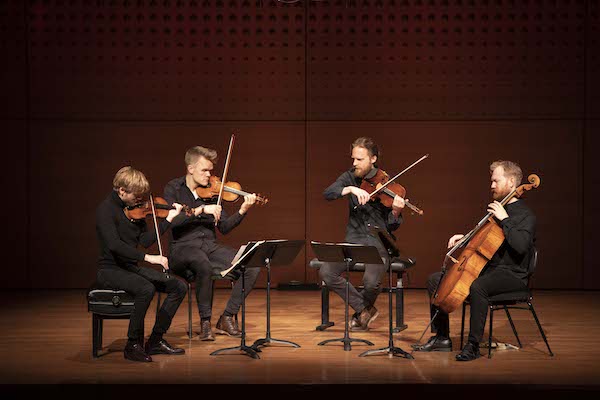Danish Quartet romps in Beethoven’s Razumovskys

The third concert of the Danish String Quartet’s Beethoven cycle at the Chamber Music Society of Lincoln Center dove into the master’s middle period: the three Op. 59 “Razumovsky” Quartets, which show a mature composer who has at last found his distinctive voice in formal innovation.
These three are far more complex than the six Op. 18 quartets that came before, so a program of the “Razumovsky” Quartets makes for a substantial evening, especially by the standards of chamber concerts. Clocking in at well over two hours, this Tuesday concert at Alice Tully Hall proved a rich meal.
The distinguishing feature the Danish String Quartet showed off on Tuesday was a naturally breathing energy, maintaining a sense of complete ease even at their quickest tempos. In the opening Allegro of the Quartet No. 1 in F major, a warm, orange glow in their tone set up a dramatic contrast with the quiet tension in the fugue-like start of the development. The Danish Quartet were at their best when playing in tight dynamic sync, as in the scherzo, where every hairpin turned in perfect unison. They showed a strong feeling for the direction of this movement, as its initial elegance gave way to a more pesante roughness.
These quartets feature exceptionally long slow movements, requiring constant focus to keep them from falling into stasis. The F-major quartet’s Adagio molto was stunning—simply played yet with deep feeling, as one pining melodic line rose over another. A soft light in their sound kept the tender melancholy of the music vivid, even when all four voices dropped together to a whisper. They held the focus of this movement so well that the transition into the lively, witty finale seemed to come out of nowhere.
The Quartet No. 2 in E minor started off well, with quick-pulsed darkness, creating a torrent-like effect as running passages passed seamlessly from one voice to the next. On the whole, though, this quartet showed less polish than the other two. Questionable tuning persisted throughout the piece, beginning in the second movement, which was otherwise exemplary. Here, as in the F-major quartet, they maintained impressive focus in a long adagio, allowing the melody to expand through its long, arching lines.
That sustained energy fell off in the last two movements: the Allegretto needed more contrast between its moving and static voices, and while the overall pace of the Finale was a lively trot, the individual lines craved sharper articulation.
The Quartet No. 3 in C major showed a return to form, proving the best of the night. With the tuning issues resolved, the Danish Quartet were able to stew in the opening chord progressions, allowing their dissonance to ferment and letting us hear Beethoven’s transgressive side. In the main body of the first movement, they dug into the strings and emphasized the pulses of the music, drawing a clear distinction between the lively, earthy sound of the allegro sections and the stretches of quieter poise. They showed a remarkable ability to blend between textures, moving from sharp definition to a softer haze like a camera adjusting its focus.
The players crafted shapely dynamic contours in the Andante, creating a cycle of building and releasing sonic tension. In the Menuetto they brought grace and humor, playing on the clever transitions between the stately minuet and its spry trio. The closing Allegro molto was simply brilliant: playful and giggling, this last movement thrummed with ecstatic energy, darting back and forth among its four voices. In the context of such a dense evening of music, this was a sparkling finish—so much so that the Danish Quartet offered a reprise of the finale as their encore, after taking their third bow.
The Danish String Quartet’s Beethoven cycle continues 7:30 p.m. Friday at Alice Tully Hall, with a program of the Op. 74, 95, and 127 quartets. chambermusicsociety.org






